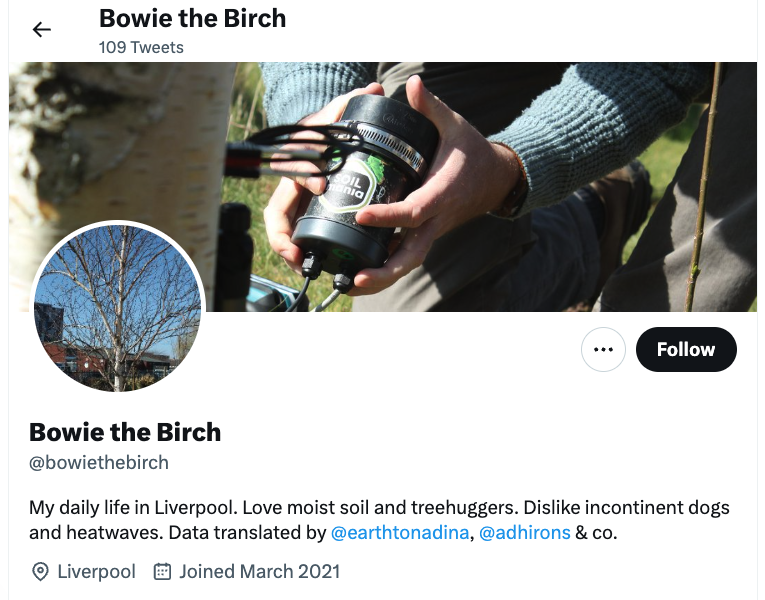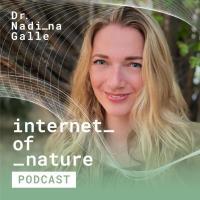_(1).JPG)
Make soil great again
Make soil great again
How a tweeting tree raises awareness on urban forest soil
BY DR. NADINA GALLE
TOP IMAGE: Dr. Andrew Hirons, tree biologist and senior lecturer in arboriculture at Myerscough College (UK), poses with @bowiethebirch.
In my last column, you met Dr. Tim Rademacher, a self-proclaimed “scholar of trees and technology,” and his arboreal counterpart, Whitney, a century-old red oak tweeting from the Harvard Forest in Petersham, Massachusetts. Via the Twitter account @awitnesstree, Whitney keeps her 10,000 plus followers informed about her sap flow, secondary growth, and how she “feels” about — and reacts to — extreme weather events.
Whitney was not the first tree to have a Twitter following. Like me, Tim was inspired by colleagues at Ghent University, who set up the world’s first tweeting tree in 2016, and currently monitors sensor data from 21 trees across Belgium, Germany, India, the Netherlands, and the UK. The 10-year project is known as TreeWatch.net. On a warm summer day, the tree on Wageningen University & Research campus proudly proclaimed: “Today, I have grown 0.082 millimetres, transported 124.9 litres of water at a maximum sap flow of 9.8 litres per hour.” By studying the live data output from trees, researchers are able to gain insights into how plants responded and adapted in past climates of distress. This information can then be used to create predictive models that will help shape our future understanding of urban forests.
In 2021, renowned tree biologist Dr. Andrew Hirons and I were tremendously inspired by both TreeWatch.net and Tim’s live-tweeting brainchild. We felt, however, that more could be done to raise awareness on the plight of city trees and the underground world of soil health, which in large part determines the health of the tree. Thus, with the support of UK community forest organization, Mersey Forest, and Dutch soil sensor company, SoilMania, our own tweeting tree — @bowiethebirch — was born. Let me introduce you to Bowie.

Like Whitney, Bowie makes use of sap-flow sensors to measure his vascular health like a heart monitor, a dendrometer to measure his growth, and relative humidity and temperature sensors to understand his microclimate. What makes Bowie unique is where he lives — he is one of the world’s first urban tweeting trees, dealing with uniquely urban issues like soil pollution, compaction, heat island effect, urinating dogs, and more. Bowie is also connected to a state-of-the-art soil life sensor from SoilMania, which in addition to Bowie’s tree sensors, measures soil moisture, pH, electrical conductivity (salinity), temperature and oxygen levels.
A healthy canopy lies underground
Imagine you’re standing in front of a maple tree. It has paler, smaller, and fewer leaves than in previous years that have changed to fall colours far before the end of summer. How would you go about diagnosing that tree?
Our most immediate reaction might be to look up at its crown, but in order to assess the overall health of a tree, it is essential to understand what lies beneath the surface. While many arborists and green professionals may focus on looking up at the leaves and branches, they often forget to look down into the soil. Health starts from the bottom, as the nutrient-rich soil that contains diverse organisms critical for growth gives trees a reliable foundation. If a tree’s root system lacks nourishment or experiences disturbances, then it will be unable to support healthy growth above ground. And without a strong root system, any efforts to help trees stay healthy are likely to be in vain. Soil is what trees grow in, providing support, nutrients, and a network of water and air to the plant’s roots. Farmers obsess over soil health to ensure a healthy harvest. Why don’t we do the same when growing trees in the city?

Soil life sensors are a powerful tool for understanding soil health. By measuring soil moisture, pH, salinity, temperature and oxygen levels, these sensors can provide insights into the nutrient content of the soil, the presence of pollutants and potential contaminants, as well as an early warning sign of problem areas in the ecosystem. The data collected will allow you to witness the immediate impact various factors have on soil health and with that, observe how vital it is for tree and shrub growth. Events and interventions like mechanical pressure, weed control, fertilization or weather conditions are now visible in real time.
A digital Lorax, speaking — or rather tweeting — for trees
That data could be kept to arborists, urban foresters and municipalities — or we could use it to achieve an even greater goal: revealing the hidden life of trees to urbanites around the world. By translating tree and soil data to automatic — and most importantly, fun (!) — tweets, Bowie is like a digital Lorax, speaking — or rather tweeting — for the trees. We might not be able to see it, feel it or hear it, but under our feet lies the matrix that can make or break a tree’s life. Especially in a city where trees face increasingly harsh conditions.
 @bowiethebirch regularly reports its soil moisture levels, which are provided by a SoilMania sensor.
@bowiethebirch regularly reports its soil moisture levels, which are provided by a SoilMania sensor.
By communicating about the growth, challenges and opportunities Bowie faces, citizens can learn about the importance of healthy soil to grow healthy trees in cities for generations to come. But we didn’t want these lessons to stay only in Liverpool, where Bowie lives. Creating Bowie led to the development of SoilMania’s Tweeting Tree Kit, which comes complete with everything you need to set up your very own digital Lorax. It’s a unique and innovative product which can be installed on any tree of choice, acting as a representative for all of the city’s trees, like a “tree mascot” for the community.
 Dr. Nadina Galle spotlights Internet of Nature (IoN) technologies and practitioners making a difference in how we can optimize soil health, manage urban forests, create liveable cities, and everything in between. To learn more about the IoN and to catch episodes of the Internet of Nature Podcast, visit: nadinagalle.com.
Dr. Nadina Galle spotlights Internet of Nature (IoN) technologies and practitioners making a difference in how we can optimize soil health, manage urban forests, create liveable cities, and everything in between. To learn more about the IoN and to catch episodes of the Internet of Nature Podcast, visit: nadinagalle.com.